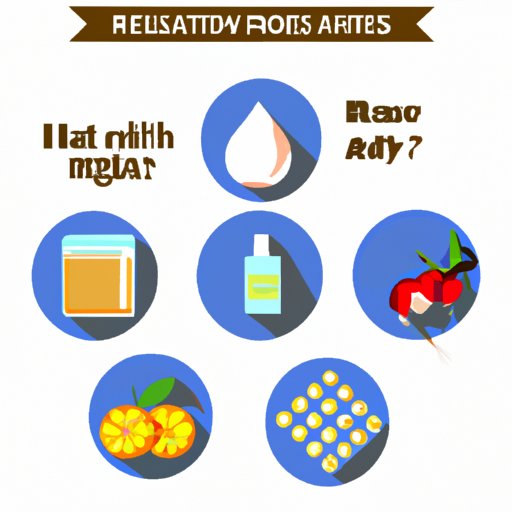
I. Introduction
Rashes are a common skin condition that can be itchy, painful and unsightly. They can also be a symptom of a more severe underlying problem. Getting rid of rashes is essential to alleviate discomfort and prevent further complications.
II. Natural Remedies to Get Rid of Rashes
Natural remedies are great alternatives for treating rashes. They are safe, cost-effective, and most importantly, they work.
A. Overview of Natural Remedies for Rashes
Natural remedies often contain several compounds that soothe the skin, reduce inflammation and promote healing.
B. Home Remedies
Common home remedies include aloe vera and oatmeal baths.
1. Aloe Vera
Aloe vera is a natural plant that contains antioxidant and anti-inflammatory properties that help to soothe itchy and irritated skin. Apply aloe vera gel to the affected area 2-3 times a day until the rash subsides.
2. Oatmeal Baths
Oatmeal contains anti-inflammatory properties that soothe the skin and reduce itching. Adding oatmeal to your bathwater can greatly alleviate rashes caused by poison ivy, insect bites, and other skin irritations.
III. Medications to Treat Rashes
If home remedies do not work, over-the-counter or prescription medications can help to ease symptoms.
A. Over-the-Counter Medications
1. Hydrocortisone Cream
Hydrocortisone cream is an over-the-counter medication that contains anti-inflammatory and anti-itch properties that help to reduce redness and itchiness. Apply a thin layer of the cream to the affected area 2-3 times a day for up to one week.
2. Antihistamines
Antihistamines soothe itchy and inflamed skin. They are often used to treat hay fever and allergies but can also be effective in treating rashes caused by poison ivy, insect bites, and other skin irritations.
B. Prescription Medications
1. Topical Steroids
Topical steroids are prescription medications that contain anti-inflammatory properties. They are often used to treat eczema, psoriasis, and other severe skin conditions. Apply a thin layer of the cream to the affected area 2-3 times a day for up to two weeks.
2. Oral Antibiotics
Oral antibiotics are only prescribed for bacterial infections that cause rashes, such as impetigo. Take the medication as directed by the doctor.
IV. Understanding Different Types of Rashes and Their Causes
Knowing the different types of rashes and their causes can help determine the best treatment methods.
A. Overview of Rash Types
There are several types of rashes, such as eczema, psoriasis, and contact dermatitis.
B. Causes of Common Rashes
1. Eczema
Eczema is a chronic skin condition that causes dry, red, and itchy patches of skin. It occurs due to environmental and hereditary factors.
2. Psoriasis
Psoriasis is a chronic autoimmune disorder that causes scaling, itching, and thickened patches of skin. It is caused by an overactive immune system.
3. Contact Dermatitis
Contact dermatitis is a common skin rash caused by a reaction to an irritant or allergen.
V. Importance of Hydration
Drinking plenty of water is essential for healthy skin.
A. Explanation of How Water Affects Skin Health
Water hydrates the skin and helps to flush out toxins that can cause rashes and other skin problems.
B. Relationship between Dehydration and Rashes
Dehydration can cause dry skin, which can lead to rashes. It also weakens the skin’s natural defense against environmental irritants and bacteria. Drink at least eight glasses of water daily to keep your skin hydrated.
VI. Change in Diet
Diet affects overall health and can significantly influence skin health.
A. Overview of How Diet Affects Skin Health
Foods that are high in omega-3 fatty acids, vitamins A, C, D, and E, and antioxidants can reduce inflammation and promote skin health.
B. Foods that Can Reduce Inflammation
Eating foods such as fish, nuts, leafy greens, and fruits can help to reduce inflammation and improve skin health.
VII. The Significance of Proper Skincare
Your daily skincare routine plays an essential role in preventing rashes and maintaining skin health.
A. Development of a Healthy Skincare Routine
Develop a skincare routine that includes the following steps: cleansing, toning, moisturizing, and sun protection. Use gentle, fragrance-free products that suit your skin type.
B. Daily Routines to Help Prevent Rashes
Take a shower or bath after sweating, avoid harsh soaps and detergents, and wear breathable clothing to help prevent rashes.
VIII. Medical Attention
Seek medical attention if your rash is severe, covers a large area of the skin, or lasts more than one week.
A. Signs and Symptoms That Warrant Medical Attention
If you experience symptoms such as fever, swelling, pus, pain, or difficulty breathing, seek medical attention immediately.
B. Medical Treatment Options
Medical treatment options include prescription creams, oral medications, and light therapy. Your doctor will recommend the best treatment option based on the cause and severity of your rash.
IX. Conclusion
Rashes can be painful, unsightly, and a symptom of a more severe underlying problem. Different types of rashes require different treatments. Natural remedies, hydration, a change in diet, proper skincare, and medical attention are essential for getting rid of rashes and maintaining skin health.
Summary
How to get rid of rashes? This article provides detailed information on the natural remedies, medications, different types of rashes, importance of hydration, change in diet, proper skincare, and medical attention. By following the guidelines, you can effectively treat rashes and maintain healthy skin.





